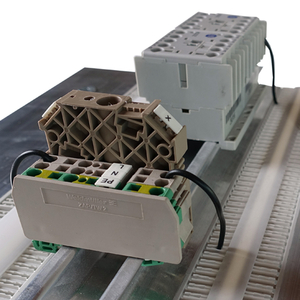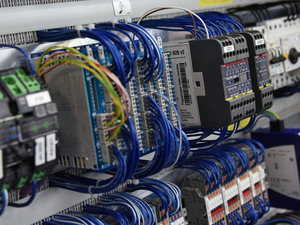
The assembly of the wiring frame basically consists of three main elements:
Vertical and horizontal profiles and mounting brackets or supports, which mechanically connect the vertical and horizontal elements by means of bolting.
The brackets or supports save space for the rearward wiring. In addition, the brackets on the left and right in the vertical direction form the rear cable duct. The following dimensions have been a standard until today: 50, 80 and 120 mm for the bracket height. This distance measure determines which wire volume can be used. Of course, other dimensions, both with brackets and with spacers, can be implemented. The brackets are isolated to a dielectric strength of 5 kV.
The horizontal profiles are selected according to the electric components and are cut corresponding to the width of the selected switching cabinet. The profiles can be arbitrarily lined up in a grid dimension of 20 mm. Thus, an infinitely large variety of new combinations is formed. You will benefit from over 60 different standard profiles.
The vertical profiles determine the necessary stability in height as well as the dimensions of the wiring system. You will benefit from over 10 different standard profiles.
The screwed connections are clearly defined regarding initial torques and type of screws. The frame system was tested for shock and vibration and exceeds the requirements of railway technology.
EN 61373 - 1B
When using the wiring system, you have a very high flexibility of component arrangements. Combine the vertical and horizontal arrangement of electrical components within the same wiring frame.
For installations, a vertical arrangement is often selected for terminal strips that are needed for cable inputs and outputs and a horizontal arrangement is chosen for the placement of electrical components.

It is possible to assemble the wiring frames horizontally on assembly tables or vertically directly in the switching cabinet.
In case of vertical placement, you save additional mounting area in your production facilities.

What is valid for the assembly can also be implemented when wiring. Horizontal wiring is used more frequently and has the advantage of a uniform wiring height. It is very pleasant and convenient for those responsible.
Vertical wiring, which is usually carried out directly in the switching cabinet, is slightly faster and reduces the mounting area by at least 50%.
The two wiring strips, different in size, can accept a cross section of 0.5 to 16 mm² and are fixed in a corresponding position. If larger cross-sections are used, these can be fixed by mechanical mounts, which are bolted directly to the horizontal profile. Thus, there are no limits with respect to cross-sectional dimensions.
Tip:
When wiring, this will set the course for an optimal wire tracking.
Please be aware that the wire must have a reserve in length of about 2 - 3 cm and is not pulled tight over the mounting bracket. Thus, sufficient clearance is guaranteed which also subsequently allows for easy tracking of the wires.